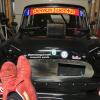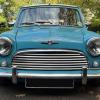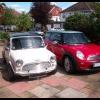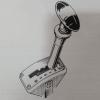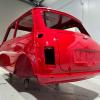The Japanese market for Rover Minis started to grow in the 1980's when some diehard Japanese Mini enthusiasts (like Mr Maruyama below) asked John Cooper to produce 'Cooper upgrade kits' to ship to Japan to convert their 998ccc Rover Minis imported from the UK to Cooper spec. A long story but eventually John Cooper was able to convince Rover that re-introducing a 1275cc Mini Cooper using the MG Metro engine for the Japanese market would satisfy a demand in Japan and boost Mini sales in the UK and other export markets. That finally happened in 1990 with the introduction of the RSP Mini Cooper and the rest is history....without the demand from Japan it is unlikely the Mini Cooper would have been re-launched and kept the Mini in production until 2000.

Mr Maruyama and his Minis.
"There is probably no one in Japan who feels as close to the Mini brand as Kazuo Maruyama. The 74-year-old has had a deep passion for the little car since the 1960s. Many historic models are on display in his workshop – including one of the oldest Mini ever, and a special racing car by John Cooper.
When it comes to collecting cars in Japan, few can compete with Kazuo Maruyama. The 74-year-old who runs Mini Maruyama, a museum-like garage in central Tokyo, owns a spectacular body of vehicles, many of which cannot be found anywhere else. This includes one of the world’s oldest Mini, a present he received from the car’s inventor, Sir Alec Issigonis. The second Mini to be made, it was a prototype that wasn’t put on the market. The first was used purely for crash testing so it’s no longer around. The late Issigonis, a good friend of Maruyama’s, passed on the historic car to the Japanese man in a show of appreciation for all he had done to help the company. Known as the man who revived the classic Mini when the car was struggling to sell in the 1980s, Maruyama has been collecting, restoring, selling, repairing and, of course, driving the iconic British vehicle for decades.
His garage, a hidden gem located in a nondescript area of Tokyo, is a must-visit for car lovers visiting Japan’s capital. It boasts historic photographs and a great selection of accessories in addition to all the cars. Walking around the place, you can see his devotion to the Mini."
"For ordinary citizens in Japan, getting hold of a Mini wasn’t easy in the beginning. Japan first imported the Mini in the spring of 1960; however, it was still quite difficult for regular folks here to buy cars back then since we’d lost the war and had lots of restrictions imposed on us,“ remembers Maruyama.
Another issue was the exchange rate as the pound was so high compared to the yen. It was a humble car meant for low-income households that was intentionally designed to be driven and maintained for long periods and at a reasonable price, but in Japan it became a luxury item as it was so expensive here,“ continues Maruyama. Comparatively, Volkswagens that came from Germany were half the price of the Minis since they’d lost the war, too.“
According to Maruyama, the fact that most people in Japan couldn’t afford the Mini added to its allure for those who could. Owning one in Great Britain was trendy, but in his country it had even more of a status symbol. On top of that, Japanese consumers loved the car’s size and how efficiently it ran. From a personal perspective, Maruyama’s long been attracted to the mechanical construction of the vehicle and its analogue nature, which he describes as “adorable”.
"In the early 1980s, as there were only a relatively small number of dedicated fans interested in purchasing Minis, Maruyama developed a strategy to boost interest in the car. He provided the vehicles modified at his company to be used as props in advertisements and television commercials.
The extra exposure had the desired effect. New fans emerged including many women who felt the Mini was both charming and fashionable. Japan was going through something of a “retro boom” at the time and the Mini had that nostalgic feel to it, reminding people of simpler times. Though evolving to keep up with the modern age, it remained true to its origins.
Several private Japanese dealers consequently took advantage of the car’s popularity by importing the vehicles themselves. Realising it was missing a trick, British car manufacturer Rover then officially started exporting Minis to Japan in 1985. Though keeping the designs the same, the British factory added more chrome and leather to the automobiles for the Japanese market."
"Soon enough, more than half of the Minis manufactured in the U.K. were being shipped to Japan. In the late ‘80s, Rover had considered ceasing production of the car due to poor sales in Europe. The Far East market effectively kept it alive. Without the influence of one man, that probably wouldn’t have been possible.
Maruyama was key to the car’s success in Japan, and anyone associated with the Mini appreciated his endeavours. That, of course, included John Cooper, with whom he established a close connection."
More here:-
https://www.mini.com...-his-minis.html
Edited by mab01uk, 14 February 2025 - 07:53 PM.




